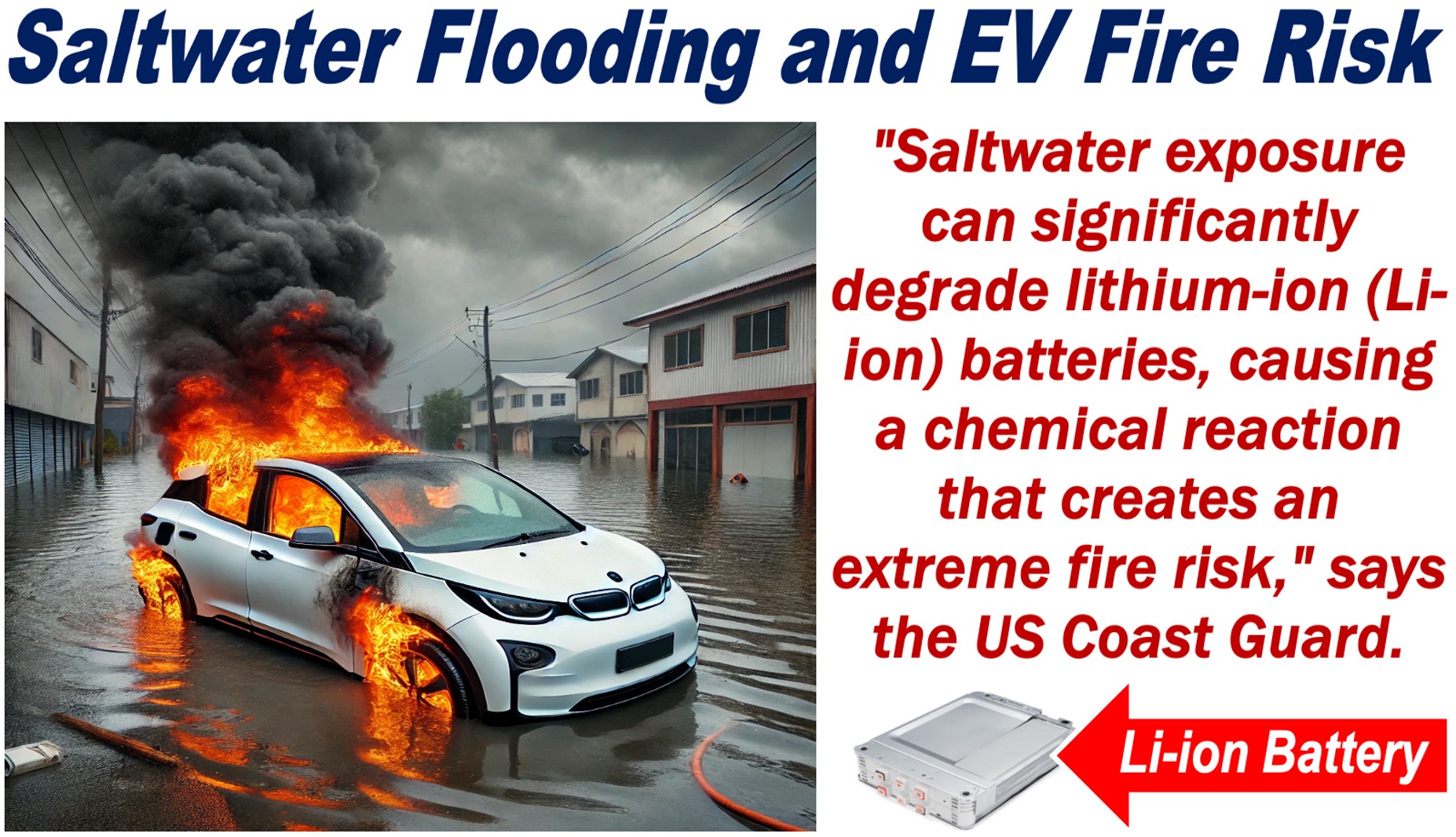As Hurricane Helene ravaged Florida, a new threat emerged beyond the destructive winds and storm surges: electric vehicle (EV) fires.
Florida, with over 250,000 registered EVs, is seeing a rise in fires caused by lithium-ion batteries exposed to saltwater.
This article examines the risks, safety measures, and how this issue has persisted across multiple hurricanes.

Saltwater and Lithium-ion Batteries: A Dangerous Combination
The interaction between storm surges and electric vehicle batteries has led to a concerning pattern of fires, particularly in Florida.
Following Hurricane Helene, numerous incidents of EVs igniting were reported, leading to extensive property damage and safety concerns.
Officials highlight that these fires are triggered by saltwater exposure to lithium-ion batteries.
When saltwater infiltrates EV batteries, it can cause a phenomenon known as thermal runaway. This occurs when the salt bridges the gap between battery cells, leading to a short circuit and subsequent self-heating, which often results in a fire.
Past Hurricanes and EV Fire Incidents
Florida is no stranger to EV fires following hurricanes. Similar occurrences were reported after Hurricanes Idalia and Ian.
During Hurricane Ian, for instance, over 5,000 EVs were compromised, with 36 catching fire.
Officials believe that increased awareness helped prevent further incidents during Hurricane Helene, but the risks remain high, particularly for those unable to relocate their vehicles to safer locations.
Safety Warnings and Precautions for EV Owners
Florida officials, including Governor Ron DeSantis and State Fire Marshal Jimmy Patronis, strongly advised EV owners to move their vehicles to higher ground ahead of Hurricane Helene’s landfall. This was in anticipation of storm surges reaching up to 20 feet in some areas.
To minimize the risk of fires, experts recommend keeping EVs out of standing water and moving them at least 50 feet away from any structure if saltwater exposure occurs (see Tesla’s guidance below).
The National Highway Traffic Safety Administration (NHTSA) advises that even after water evaporates, salt deposits may remain, posing a continued risk for days or even weeks after the floodwaters have receded.
The Complexity of EV Fires
One of the primary challenges posed by EV fires is their resistance to traditional firefighting methods. Lithium-ion battery fires are difficult to extinguish, often reigniting multiple times even after being doused with water.
Florida firefighters have repeatedly encountered this issue, as noted by Jimmy Patronis after witnessing the resurgence of fires during Hurricane Ian operations.
Electric vehicles require specialized techniques to extinguish battery fires, making it imperative for fire departments to remain vigilant and prepared, especially in flood-prone regions.
Tesla’s Guidance
Elon Musk’s electric vehicle maker, Tesla, provides specific guidance for handling electric vehicles (EVs) that have been submerged in water, particularly saltwater, due to flooding or other extreme weather conditions.
If a Tesla vehicle has been exposed to saltwater, the company recommends treating it as if it has been in an accident and advises not to operate the vehicle until it has been inspected by a qualified service provider.
Tesla owners are urged to move the vehicle at least 50 feet away from structures or other combustible materials to prevent potential fire hazards.
The company advises its customers to seek towing assistance and schedule inspections through Tesla Service to ensure safety.
Furthermore, Tesla underscores the importance of moving the vehicle to higher ground if a submersion event, such as a hurricane-induced flood, is forecasted.
Looking Ahead: Improving EV Safety
As the number of EVs on Florida’s roads continues to rise, so too does the importance of addressing the risks associated with their batteries during floods.
The NHTSA is actively working to improve battery safety standards, while Florida officials are advocating for greater public awareness and legislative action to mitigate these risks.
While lithium-ion batteries are designed with safeguards such as insulation barriers and moisture seals, they are not immune to the effects of prolonged exposure to saltwater.
As hurricanes become more frequent and intense, it becomes crucial for both car manufacturers and regulatory bodies to focus on enhancing battery resilience in flood-prone areas.
Final Thoughts
The rise of electric vehicles brings many environmental benefits, but it also introduces new challenges, particularly in regions like Florida prone to hurricanes and flooding.
With proper precautions, such as moving EVs to higher ground and ensuring they are thoroughly inspected after exposure to saltwater, many of these risks can be mitigated.
However, as hurricanes like Helene show, continued education and vigilance are necessary to prevent further incidents.
